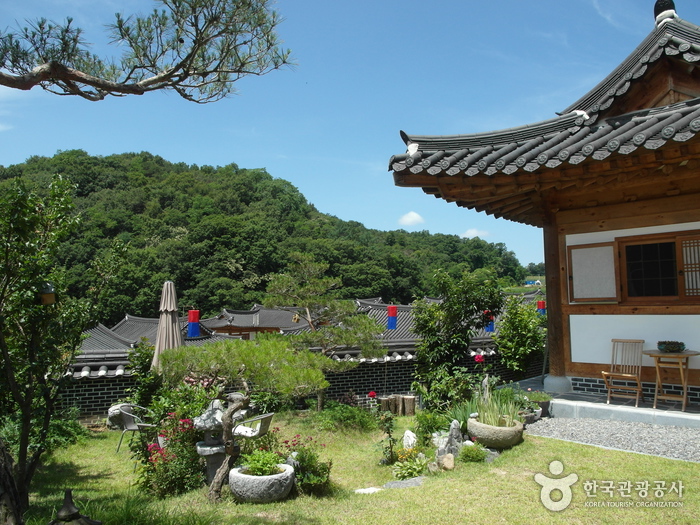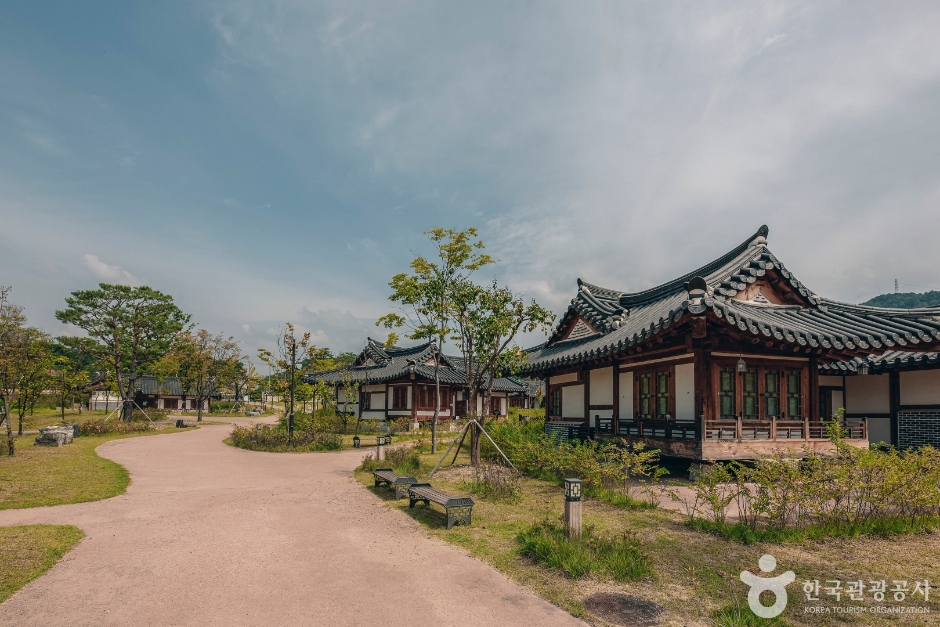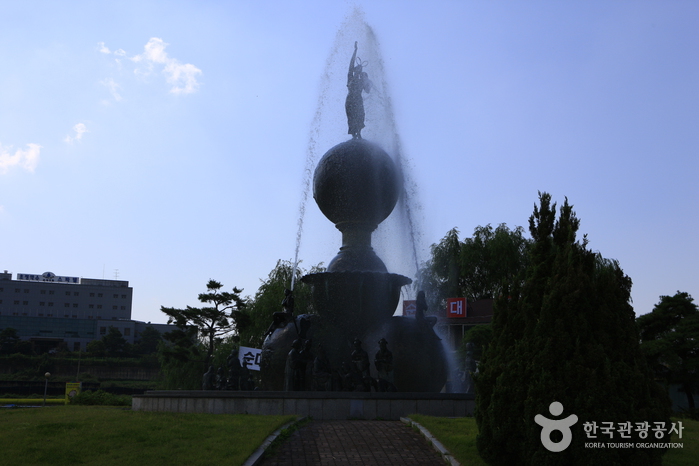Café Forecyan (카페 포레시안)
5.9Km 2024-02-23
643 Sanseong-ro, Sangdang-gu, Cheongju-si, Chungcheongbuk-do
Café Forecyan is located near the Sangdangsanseong Fortress, renowned for being a pleasant drive away. This spacious bakery-café is celebrated for its picturesque pond photo spot and captivating ice fountain during winter. Guests can indulge in a variety of delicious options such as coffee, yogurt, ice cream, tea, and child-friendly drinks. The menu also features a Fruits Party platter with 5-6 different fruits, sogeum baguette (salted baguette), fruits pie, and cake, all popular among visitors. The café is surrounded by a lush front yard filled with grass and flowers, and a serene backyard adorned with birch trees and hydrangeas, offering splendid views for a delightful visit.
Yangleem & Café Humanitas (인문 아카이브 양림 & 카페 후마니타스)
6.2Km 2024-02-23
25, Jubong-ro 15beon-gil, Heungdeok-gu, Cheongju-si, Chungcheongbuk-do
Yangleem & Café Humanitas offers a unique blend of culture and relaxation, featuring an archive housed within a traditional hanok and a contemporary café. The establishment is permeated with the comforting scent of wood and books, merging the architectural elegance of hanok with modern design elements. The café's balcony provides breathtaking views of Jubong Reservoir, adorned with lotus flowers, and the surrounding rice paddies. Their signature beverage, the yeonnip spänner (lotus leaf einspänner), along with espresso, lattes, and herbal teas, are among the favored selections.
Homeplus - Ochang Branch [Tax Refund Shop] (홈플러스 오창)
9.2Km 2024-04-22
8-11, Jungsimsangeop 1-ro, Ochang-eup, Cheongwon-gu, Cheongju-si, Chungcheongbuk-do
-
Cheongju Sutbul Galbi (청주숯불갈비)
11.2Km 2024-03-25
422 Taeseongtabyeon-ro, Gangnae-myeon, Heungdeok-gu, Cheongju-si, Chungcheongbuk-do
043-232-2992
Opened in 1985, the restaurant specializes in charcoal-grilled galbi. Their signature dish, the dwaeji galbijjim set menu, features braised pork galbi, doenjang jjigae (soybean paste stew), and gonggibap (steamed rice). Favorites also include the sutbul bulgogi set menu (charcoal-grilled bulgogi), anchangsal (grilled thin skirt), saeng deungsim (grilled sirloin), and galbisal gui (grilled boneless galbi). Additionally, they offer a seasonal selection of nicely presented side dishes with homegrown vegetables. The in-house made soybean paste, crafted from their own soybeans, is notably flavorful.
Gayeongdang, Cheongju (가영당)
12.4Km 2024-12-23
71-54 , Miraeji-ro, Cheongwon-gu, Cheongju-si, Chungcheongbuk-do
+82-43-233-9966
Gayeongdang is a hanok stay in Ochang Hanok Village ( part of Ochang Miraeji Agricultural Theme Park) in Cheongju-si, Chungcheongbuk-do. The hanok was built by flower-tea master Kim Byeong-hee, using only Korean pinewood - and the rich pine scent still fills the rooms. The rooms are all ondol style. Guests staying in the main building have access to a living room and tea room, while guests in the annexe can enjoy barbecues in the yard. Visitors can talke part in a tea ceremony and enjoy flower tea and sweets while conversing with the master. The hanok can also be rented as a space for seminars, small concerts, and weddings.
Nangchugol Learning Park (낭추골 현장체험학습원)
13.0Km 2025-01-17
1890 Danjae-ro, Nangseong-myeon, Sangdang-gu, Cheongju-si, Chungcheongbuk-do
Nangchugol is a mountain village located in the eastern part of Cheongju, offering children the chance to observe and experience nature through play and a variety of activities. It boasts a goblin trail, four-season sledding options (grass sled, water sled, and snow sled), swimming pools, a nature learning center focusing on wild plants, valleys, and animals, a traditional game ground, an adventure playground, an insect experience center, and guided forest tours. Additionally, the village includes a campground for visitors.
Chojeong Haenggung (초정행궁)
13.8Km 2024-12-23
851 , Chojeongyaksu-ro, Cheongwon-gu, Cheongju-si, Chungcheongbuk-do
+82-43-270-7332
Chojeong Haenggung is a hanok stay and hanok experience center in Chojeong Culture Park, Cheongju, Chungcheongbuk-do. The house has a historic royal connection, as King Sejong stayed here for some months in 1444 while being treated for an eye problem. There are 12 guestrooms, all with an underfloor-heated ondol room and either a daecheongmaru (large wood-floored hall) or a numaru (raised wooden floor space). All rooms have a bathroom and toilet. Cooking is not possible, but there’s a microwave oven and kettle for preparation of instant meals. There are discounts for Cheongju residents.
Chojeongyaksu Mineral Spring (초정약수)
13.8Km 2022-07-29
Chojeong-ri, Cheongwon-gu, Cheongju-si, Chungcheongbuk-do
+82-43-201-2042
Located approximately 16 kilometers northeast of Cheongju City, Chojeongyaksu Mineral Spring is acknowledged as one of the three major mineral springs in the world. Chojeong Mineral Spring was discovered around 600 years ago and became nationally known ever since as the source of naturally carbonated water that has a piquant and cool taste. It is said that King Sejong (1397-1450, reign 1418-1450) visited the springs in 1444 and stayed here for 60 days to treat an eye infection. The daily yield of carbonated water here is 458 tons, which is used for producing natural soda drinks. There are presently two mineral water plant facilities in the area. The healing effects of Chojeongyaksu Mineral Spring are presumed to come from the abundant radium contained in the water, which is effective in treating eye infections and skin ailments.
Café Droptop (Osong Underpass Branch) (드롭탑 오송역언더패스점)
13.8Km 2024-02-23
15-4 Osong-ri, Osong-eup, Heungdeok-gu, Cheongju-si, Chungcheongbuk-do
Situated at KTX Osong Station, Café Droptop is a 24-hour unmanned coffee shop within a distinctive yellow container. Here, robots are tasked with preparing a wide selection of drinks, including espresso, latte, and caffè mocha. The café offers free parking on the day of purchase, enhancing its appeal. Conveniently, it's just a 5-minute walk from the Korail platform and near Exit 3 of Osong Station.
Munui Cultural Properties Site (문의문화재단지)
15.0Km 2022-12-27
721, Daecheonghoban-ro, Sangdang-gu, Cheongju-si, Chungcheongbuk-do
Munui Cultural Properties Site, overlooking the Daecheongho Lake, attracts many visitors. The site was created to preserve and promote the local traditional culture of Cheongwon (Chungcheongbuk-do); it is a great place to learn about local history, culture, and arts.
The spacious complex (132,232m²) is a home to ten traditional houses (Munsangwan, aristocrat houses, a museum, and a tavern), showing a form of a traditional village. It is also full of dolmen stones (symbolizing abundant procreation), Jangseung (totem poles at the entrance of villages or temples), and Yeonjabanga (millstones worked by horses or oxen), providing visitors with opportunities to learn about traditional culture and life.
With a theme of roof tiles, a relics gallery in the complex boasts over 774 local items, categorized by historical period (e.g. the Silla Period, Baekje Period, etc.). Munsan-ri Stone Bridge, believed to have been built during the Goryeo Period, was restored in front of the gallery.
The complex also offers a wide array of amenities including mineral spring sites, playgrounds, and Munui Movie Village (a drive-in movie theatert). Nearby notable attractions include artificial falls, Yangseongsan Mountain, Jakdusan Mountain, Daecheongho Lake, Nosan Pine Forest, Donghwasa Temple, and Bugang Mineral Springs.

![Homeplus - Ochang Branch [Tax Refund Shop] (홈플러스 오창)](http://tong.visitkorea.or.kr/cms/resource/62/2882962_image2_1.jpg)





 English
English
 한국어
한국어 日本語
日本語 中文(简体)
中文(简体) Deutsch
Deutsch Français
Français Español
Español Русский
Русский